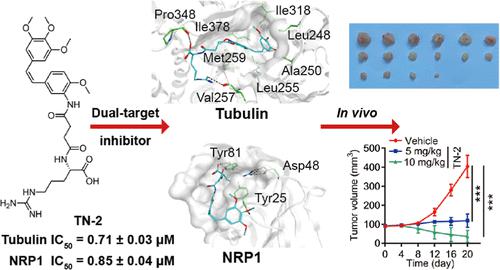当前位置:
X-MOL 学术
›
J. Med. Chem.
›
论文详情
Our official English website, www.x-mol.net, welcomes your
feedback! (Note: you will need to create a separate account there.)
Discovery of a Dual Tubulin and Neuropilin-1 (NRP1) Inhibitor with Potent In Vivo Anti-Tumor Activity via Pharmacophore-based Docking Screening, Structure Optimization, and Biological Evaluation
Journal of Medicinal Chemistry ( IF 6.8 ) Pub Date : 2023-11-24 , DOI: 10.1021/acs.jmedchem.3c01572 Lufeng Zheng 1 , Yunting Zou 2 , Tianyuan Xie 1 , Xiuyuan Wu 3 , Yuchen Tan 3 , Shuang Mei 2 , Yifei Geng 2 , Shutong Chen 2 , Shengtao Xu 3 , Miao-Miao Niu 2
Journal of Medicinal Chemistry ( IF 6.8 ) Pub Date : 2023-11-24 , DOI: 10.1021/acs.jmedchem.3c01572 Lufeng Zheng 1 , Yunting Zou 2 , Tianyuan Xie 1 , Xiuyuan Wu 3 , Yuchen Tan 3 , Shuang Mei 2 , Yifei Geng 2 , Shutong Chen 2 , Shengtao Xu 3 , Miao-Miao Niu 2
Affiliation

|
Dual inhibition of tubulin and neuropilin-1 (NRP1) may become an effective method for cancer treatment by simultaneously killing tumor cells and inhibiting tumor angiogenesis. Herein, we identified dual tubulin/NRP1-targeting inhibitor TN-2, which exhibited good inhibitory activity against both tubulin polymerization (IC50 = 0.71 ± 0.03 μM) and NRP1 (IC50 = 0.85 ± 0.04 μM). Importantly, it significantly inhibited the viability of several human prostate tumor cell lines. Further mechanism studies indicated that TN-2 could inhibit tubulin polymerization and cause G2/M arrest, thereby inducing cell apoptosis. It could also suppress cell tube formation, migration, and invasion. Moreover, TN-2 showed obvious antitumor effects on the PC-3 cell-derived xenograft model with negligible side effects and good pharmacokinetic profiles. These data demonstrate that TN-2 could be a promising dual-target chemotherapeutic agent for the treatment of prostate cancer.
中文翻译:

通过基于药效基团的对接筛选、结构优化和生物学评价发现具有有效体内抗肿瘤活性的双微管蛋白和 Neuropilin-1 (NRP1) 抑制剂
微管蛋白和神经毡蛋白-1(NRP1)的双重抑制可能通过同时杀死肿瘤细胞和抑制肿瘤血管生成而成为癌症治疗的有效方法。在此,我们鉴定了微管蛋白/NRP1 双重靶向抑制剂 TN-2,它对微管蛋白聚合 (IC 50 = 0.71 ± 0.03 μM) 和 NRP1 (IC 50 = 0.85 ± 0.04 μM) 均表现出良好的抑制活性。重要的是,它显着抑制了几种人类前列腺肿瘤细胞系的活力。进一步的机制研究表明,TN-2可以抑制微管蛋白聚合,引起G2/M期阻滞,从而诱导细胞凋亡。它还可以抑制细胞管的形成、迁移和侵袭。此外,TN-2 对 PC-3 细胞来源的异种移植模型显示出明显的抗肿瘤作用,副作用可忽略不计,且具有良好的药代动力学特征。这些数据表明,TN-2可能是一种有前途的治疗前列腺癌的双靶点化疗药物。
更新日期:2023-11-24
中文翻译:

通过基于药效基团的对接筛选、结构优化和生物学评价发现具有有效体内抗肿瘤活性的双微管蛋白和 Neuropilin-1 (NRP1) 抑制剂
微管蛋白和神经毡蛋白-1(NRP1)的双重抑制可能通过同时杀死肿瘤细胞和抑制肿瘤血管生成而成为癌症治疗的有效方法。在此,我们鉴定了微管蛋白/NRP1 双重靶向抑制剂 TN-2,它对微管蛋白聚合 (IC 50 = 0.71 ± 0.03 μM) 和 NRP1 (IC 50 = 0.85 ± 0.04 μM) 均表现出良好的抑制活性。重要的是,它显着抑制了几种人类前列腺肿瘤细胞系的活力。进一步的机制研究表明,TN-2可以抑制微管蛋白聚合,引起G2/M期阻滞,从而诱导细胞凋亡。它还可以抑制细胞管的形成、迁移和侵袭。此外,TN-2 对 PC-3 细胞来源的异种移植模型显示出明显的抗肿瘤作用,副作用可忽略不计,且具有良好的药代动力学特征。这些数据表明,TN-2可能是一种有前途的治疗前列腺癌的双靶点化疗药物。











































 京公网安备 11010802027423号
京公网安备 11010802027423号